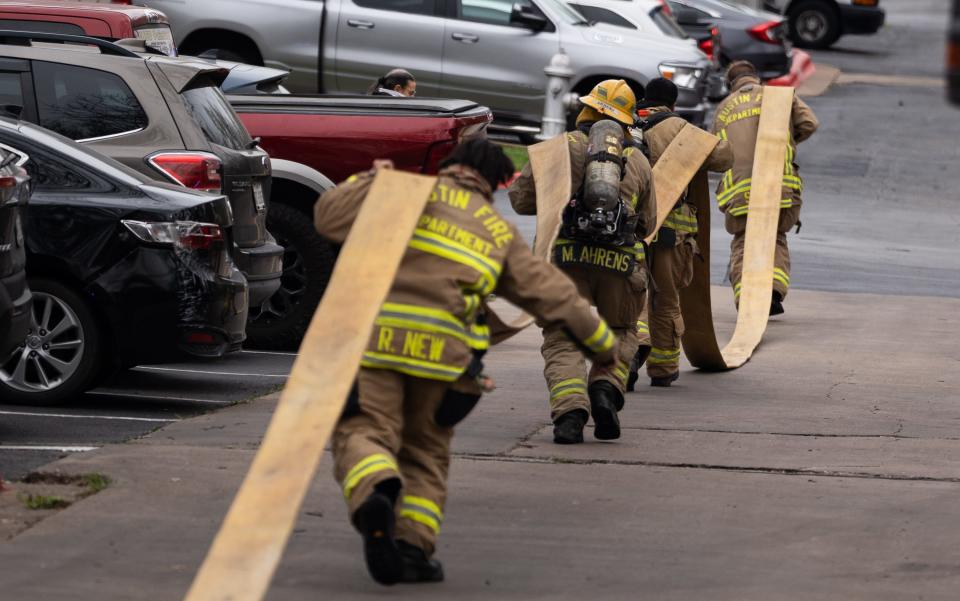'Need your help': Austin leaders look to help firefighters amid mental health crisis
Editor's note: This story contains mentions of suicide. If you or a loved one is struggling, you can call the national suicide hotline at 988.
City leaders are calling for changes to address the mental health struggles of Austin firefighters.
This comes after a firefighter died this year by suicide, and other firefighters have killed themselves in recent years, Austin Fire Association President Bob Nicks said at a press conference at City Hall on Monday. Nicks was joined by Austin City Council Members Ryan Alter, Mackenzie Kelly and Alison Alter, who said they plan to support firefighters by proposing measures aimed to help provide relief to the department.
"We need your help," Nicks said. "Your worst day may only happen once in your life. But for firefighters, these experiences are terrible, horrific events. And they see them every day, sometimes several times a day."
Nationally, firefighters have higher rates of post-traumatic stress disorder and suicide than the general population, according to a 2022 study commissioned by the philanthropic Ruderman Family Foundation.
In addition to thoughts of suicide, firefighters generally have higher levels of PTSD associated with constantly responding to highly stressful and intense calls day after day, Nicks said.
A study published in 2016 by the Journal of Occupational Health Psychology found that more than 20% of firefighters and paramedics will have PTSD at some point in their careers, compared with 6.8% of the general population. They also regularly develop sleep disorders, which typically exacerbate people's mental health conditions, Nicks said.
Sleep deprivation is increasing because firefighters are seeing their workload increase, Nicks said. When Nicks started 37 years ago, he said, a busy day would consist of a station going on five to six calls, but now busy stations will see about 20 calls per shift.
"Let us honor the memory of our fallen firefighter by taking meaningful action to ensure that no other firefighter feels alone in their struggle," Kelly said. "Our firefighters deserve our unwavering support, not only in their professional duties but in their professional and personal lives."
As the City Council works through passing next year's budget, Alison Alter said she would propose budget items aimed at easing the burden of firefighters. One would give firefighters up to 10 weeks of paid parental leave, an increase from the current six weeks, which was introduced in 2022. Another directs the city manager to study the benefits of reducing firefighters' workload and overtime usage.
Currently, Austin firefighters have 53-hour workweeks, although a stipulation of the union and the city's contract from last year reduced the workweek to 52 hours. Even so, Nicks said firefighters regularly have to work overtime to ensure every unit is fully staffed.
Ryan Alter is proposing a resolution to have an additional cadet class this year to increase the number of firefighters, which in turn can reduce firefighters' overtime usage and give them more of a chance to rest and spend time with family. To move from 53-hour to 52-hour workweeks, the Fire Department needs to add about 25 to 30 firefighters.
Nicks said the Austin Fire Department has about 1,100 firefighters with a nearly 6% vacancy rate.
Nicks said having a better work-life balance is crucial to combat the stresses that come with being a firefighter. This is part of the reason he's trying to push the department to move to a new schedule that would give firefighters 72 hours off after a shift rather than the current 48 hours.
By moving to this schedule, Nicks said firefighters would be able to unwind, relax and develop better sleeping habits, all of which affect their mental well-being. But to achieve this schedule change, they'll need more firefighters, he said.
Nicks said the city and Fire Department executives provide quality mental health care, but that much of what has to be worked on is breaking down the stigma among firefighters. He added that each of the four Austin firefighters who died by suicide in recent years was receiving help.
Amanda Bennett, a lieutenant who's worked with the Austin Fire Department for 15 years, echoed this sentiment. She said in her years of being a firefighter, she knows six people who died by suicide, four of them in Austin. Bennett almost took her own life but was saved by a friend and colleague.
Bennett compared the stress and trauma of being a first responder to that of being a frog in a pot of water. She said that at first you think you can manage to swim, but all of a sudden it's too late when you realize the water is boiling.
"Most of us will tell you we love our job; I think that is a big reason why we choose to push through the pain," Bennett said. "But remaining compassionate and showing up to assist people on their worst days takes a toll on us. I want to destigmatize and celebrate the strength that it takes to admit to others — and, most importantly, yourself — that you need help."

This article originally appeared on Austin American-Statesman: Austin firefighters struggling with mental health, recent suicide

